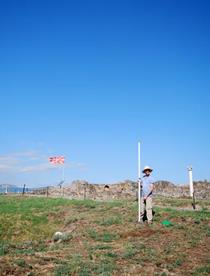
The international field school project was organized between the 29th of June and 28th of July as part of the collaboration between NI Stobi and the Balkan Heritage foundation from R. Bulgaria. In the fifth year of the field school there were 16 participants from USA, Australia, Canada and UK. The majority were anthropology and archaeology students while the rest of them were volunteers who admire archaeology and wanted the experience of an archaeological dig.
The excavations were carried out in the southwestern end of the Theodosian Palace, towards the so-called “Prison”. The goal of the excavations is to fully uncover the area between the two buildings in order to understand their relation. Having this objective, the field school campaigns in the following years will be focused on this area. During the excavations of 2014, the team worked in a room which was partially excavated in the 1930s due to what modern material was found in the excavation trenches along the walls. The room was built as a later addition after the original construction of the Palace. The floor of the room was reconstructed several times and during the 6th century the room was divided into two parts. Another trench was set to the west of the excavated room in order to document the intact stratigraphy of the area. Three successive destruction layers of collapsed stones and three level of use were documented in the trench before the excavations stopped at a level which is stratigraphically close to the later phases of the Theodosian Palace. The discovered moveable finds include pottery sherds, glass vessel shards, fragments of window glass, animal bones, bronze coins, iron arrowhead and a small white marble statue with the representation of a nude male god.
Through the direct involvement in the excavation process the participants went through all of the phases of field training and they were introduced to the principles of the locus system as a contextual methodological approach. As part of the fieldwork, the participants were also trained in technical and photo documentation, and part of the team was involved in the field inventory of the moveable finds. The program of the field school included lectures on different history and archaeology subject, as well as educative excursions to Bitola (Heraclea Lyncestis), Ohrid (Lychnidos) and Pella.
The project was conducted by the following staff: Silvana Blaževska (M. Phil.) from NI Stobi as director of the project, Angela Pencheva (PhD student) from Balkan Heritage as coordinator and field supervisor, Jovan Radnjanski as coordinator from NI Stobi and Goce Pavlovski (M.A.) from NI Stobi as field director and supervisor. The National Institution Stobi expresses gratitude to all of the participants for the outstanding collaboration and the successful realization of the project.
Click here for the field school gallery.